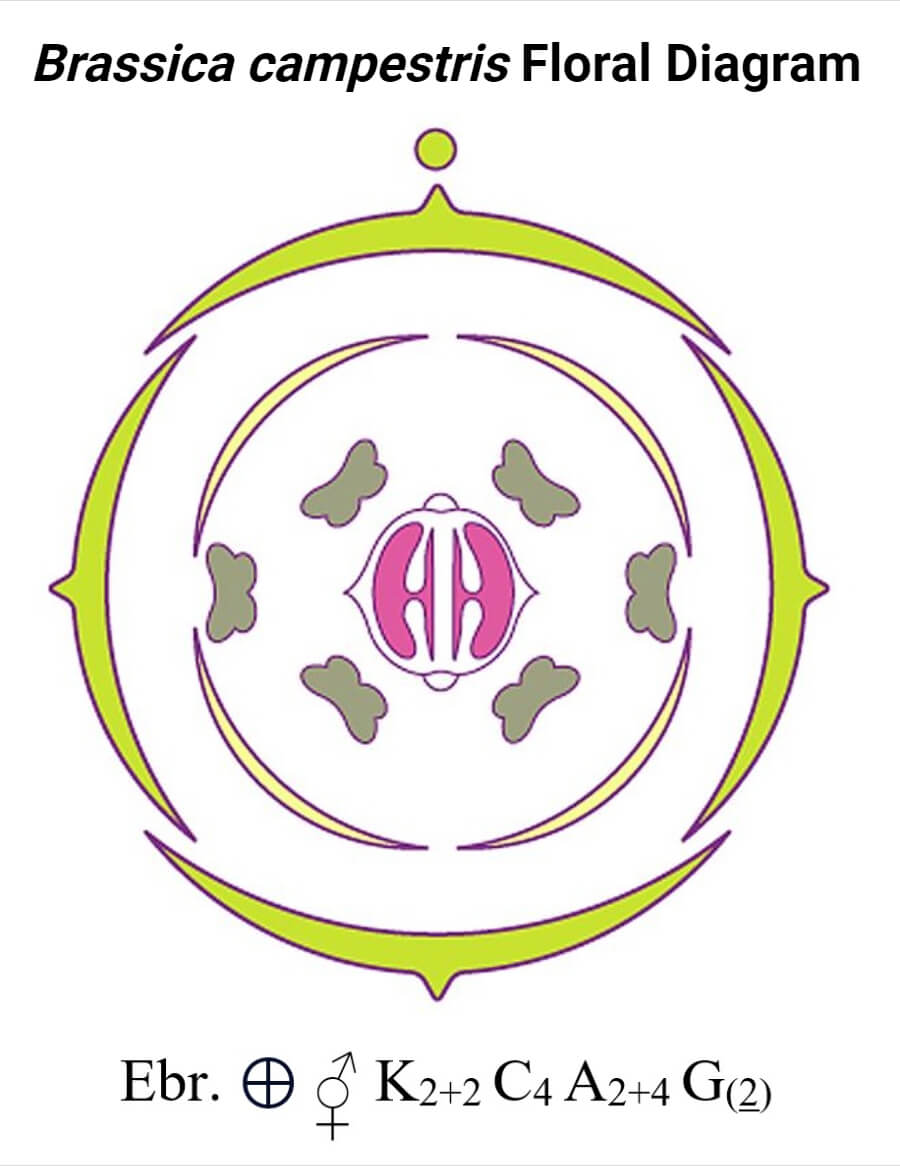The Brassicaceae family is commonly known as the Mustard family or Cruciferae family. It is a large family which comprises about 365 genera and 3250 species. It includes economically important plants used as vegetables, medicines, oil-yielding seeds, and ornamental purposes. In Nepal, there are 94 species from 38 genera reported.

Interesting Science Videos
Brassicaceae Family Distribution
- The plants of the Brassicaceae family have a global distribution.
- These plants can be found in diverse climates; primarily, most of them are found in temperate regions of the northern hemisphere.
- Many plants are cultivated for different purposes. Some species are grown for their edible parts as vegetables (Cabbage, radish, cauliflower, etc.) and other as oil yielding seeds (mustard). Additionally, certain plants are grown for ornamental purposes.
Habit and Habitat of Brassicaceae Family
- The plants are mostly herbs which may be annual, biennial, or perennial, rarely undershrubs (e.g., Farsetia, Jacquemontii)
- Most plants in this family are adapted to terrestrial habitats, while some are aquatic (e.g., Nasturtium officinale)
- The plants are often characterized by their hairy appearance
- Many Brassicaceae herbs possess a pungent smell of sulfur (sulfur-containing glucosides).
Brassicaceae Family Vegetative Characteristics
- Root: Generally possesses a tap root system. However, in some species within this family, the tap root undergoes modification to store food and assumed different shapes. Two common modified tap root forms found in this family are fusiform (radish), napiform (turnip), etc.
- Stem: The stem are typically erect, majority are herbaceous while other are rarely woody, typically solid and cylindrical, branched or unbranched depending on the species, most of the plants are hairy in which the stem are covered with fine hairs known as trichomes.
- Leaf: Radical (radish) cauline and ramal, simple , alternate, margin is smooth, serrated or lobed depending on the species, exstipulate and usually lyrate.
Brassicaceae Family Floral Characters
- Inflorescence: Racemose type
- Flower: Ebracteate, pedicellate, bisexual, complete, actinomorphic, rarely zygomorphic, tetramerous or bimerous, hypogynous, cyclic
- Calyx: 4 sepals, polysepalous, arranged in two whorls of two each, imbricate aestivation. Sepals may be caduceus, green or petalloid, inferior
- Corolla: 4 petals, polypetalous, cruciform
- Androecium: 6 stamens, polyandrous, stamens tetradynamous, arranged in two whorls, outer two stamen short while inner four stamen long, stamens having slender filaments that support the anthers at the top, the anther contain the pollen sacs where the pollen grains are produced
- Gynoecium: bicarpellary (two carpels), syncarpous, ovary superior, style short, stigma capitate, simple or bilobed, tricapellary i.e. three carpels (Lipidium), tetracarpellary i.e. four carpels (Tetrapoma)
- Fruits: Siliqua (elongated, narrow fruits with a long and slender shape) or silicula (elongated, narrow fruits with a short and broader shape)
- Pollination: cross-pollination, entomophilous, sometime self-pollination (arrangement of stamens and pistils within a flower promotes self-pollination).
- Seed: small, round to oval or elongated, non-endospermic with large curved embryo, cotyledons are oily
Brassicaceae Family Floral Formula

Brassicaceae Family Floral Diagram

Economic Importance of Brassicaceae Family
- Vegetables: Plants such as Raphanus sativus, Brassica rapa, Brassica junicea, Lepidium sativum, etc. are used for vegetables.
- Oils: Seeds of Brassica campestris (mustard), Brassica juncea (Rayo), Brassica nigra (black mustard), Brassica alba (white mustard) are used for extraction of oil which is used for cooking, burning, etc.
- Cattle feed and manure: The remains of seeds after extracting oil can be used as cattle feed and manure.
- Fodder: The leaves and other parts of the species are used as fodder.
- Condiments: The seeds of Brassica nigra, Brassica alba and Brassica juncea are used as condiments.
- Medicines: Seeds of Iberis amara and Chieranthus cheri are used in treatment of asthma and bronchitis. The seeds of Mathiola incana has anti-inflammatory and antimicrobial properties. The root of Lepidium sativum are effective against syphilis.
- Weeds: Capsella bursa-pastoris, Farsetia spp, etc. are common weeds of medicinal value.
- Ornamental purpose: Iberisamara (candytuft),Lunaria (honesty) and Chieranthus cheri (wall flower) are used as ornamental purpose and are grown in gardens.
Brassicaceae Family Identification Characteristics
- Herbaceous plant with pungent sap having sulfur-containing glucosides.
- Leaves are covered with fine hairs called trichomes.
- Flowers ebracteate, bimerous or tetramerous, bisexual, actinomorphic, and hypogynous
- Calyx contains four sepals, polysepalous arranged in two whorls.
- Corolla contains four petals, polypetalous
- Stamens are six in number, polyandrous
- Stamens are associated with green nectaries
- Carpels are two in number (Bicarpellary), syncarpous, ovary superior, and parietal placentation.
- Fruits siliqua or silicula
- Seed non-endospermic with the curved embryo.
Some common Plants of Brassicaceae Family
- Mustard: Brassica campestris
- Radish: Raphanus sativus
- Cauliflower: Brassica oleracea var botrytis
- Cabbage: Brassica oleracea var capitata
- Turnip: Brassica rapa
- Candytuft: Iberis amara
- Black mustard: Brassica nigra
- Shepherd’s purse: Capsella bursa- pastoris
- Garden cress: Lepidium sativum
- Knol (Gyanth-gobi): Brassica oleracea var. gongylodes
References
- Keshari A.K, Ghimire K.R, Mishra B.S, Adhikari K.K (2012), A Textbook of Higher Secondary Biology, Vidyarthi Pustak Bhandar, Kathmandu, pp 463-466
- https://onlinesciencenotes.com/characteristics-economic-importance-cruciferace-brassicaceae/
- https://www.studyandscore.com/studymaterial-detail/brassicaceae-general-characters-distribution-important-plants-economic-importance-and-floral-diagram
- https://www.nativeplants.org/wp-content/uploads/brassicaceae.pdf
- http://ppup.ac.in/download/econtent/pdf/1590594035835_MSC%20SEM%20II%20MBOTCC%209%20FAMILY%20CRUCIFERAE.pdf

Nice to find the detailed summary. Thanks to tek raj ji for valuable work.
We can connect on social media platforms.
My you tube channel is : pradeep sir biology.